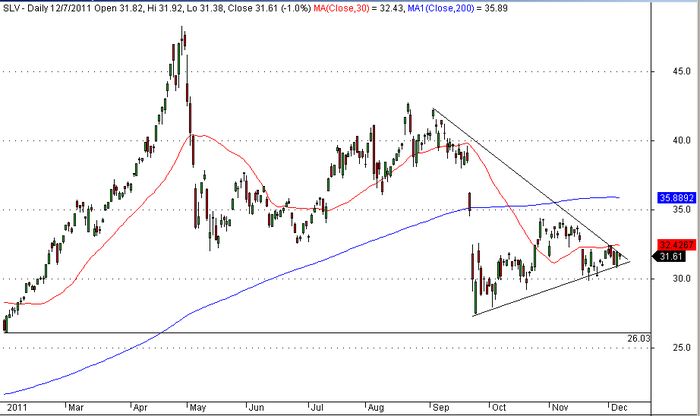Recently there have been many chart pattern failures in several markets. One must be very careful with chart analysis because the market rarely rewards predictions that are obvious to anyone with a book on technical analysis and a personal computer running a charting program. Examples of recent failures in the metal ETFs can be found in this post for GLD and in this post for SLV.
For example, let us look at the bearish triangle formation on the SLV daily chart below:
Is this chart pattern indicating that SLV will drop about 17.5% towards support near $26.03?
Frankly, I cannot say if that will happen from just looking at one pattern, especially a triangle formation that is known to be very unreliable, in general. More importantly, chart analysis without a quantitative analysis of historical performance of particular formations under similar market conditions is even worse than alchemy. That type of analysis is very hard to do for reasons that are beyond the scope of this post. Many do chart analysis because it has been done for many years. Some others do it because they want to impress readers with their knowledge. Some even do it because they actually think it works. In any case, the reader should be very careful, especially when the analyst appeals to authority, like to a popular book or charting software. Any appeal to authority in this area is a clear informal fallacy. It is like appealing to a TV series involving aliens to prove that aliens exist.
Is it possible that the target of a chart pattern will be finally reached? Here are some possibilities:
1) It will be reached because the chart pattern is valid
2) It will be reached but for other reasons (for example some big liquidation)
3) It will not be reached because the pattern will not be confirmed
4) It will not be reached because everyone sees this pattern and the market rarely rewards “everyone”.
So now someone may want to ask me the following reasonable question: “Do you believe in chart analysis and patterns?” Here is my answer:
Success does not depend on beliefs but on ways they are justified (standard epistemological principle). For example, I do not care if someone believes in God or not. I care more about how she justifies that. The added value is in the justification process not in the belief itself. But unless I sit down and do some serious quantitative work to determine things like win rates, profit factors and expectations my beliefs about any chart pattern cannot be justified. If I do the required work, chart patterns and price patterns can be very useful in indicating what may or may not happen and they can also offer hints on managing risk.
Have a good trading day!
Charting program: Amibroker (Charts created with AmiBroker – advanced charting and technical analysis software. http://www.amibroker.com/”)
Disclaimer:The author is not a financial advisor and does not recommend the purchase of any security or advise on the suitability of any trade or investment in any timeframe. ETF, stock, futures, forex and options trading and investing involves substantial financial risks and can result in total loss of capital. If investment or other professional advice is required, a licensed professional should be consulted.







